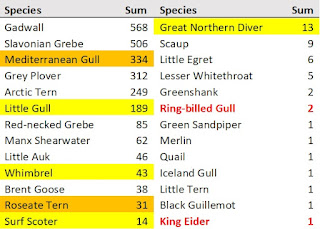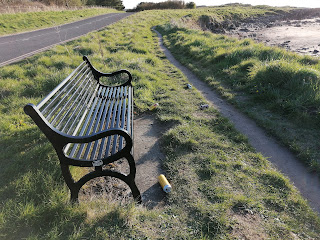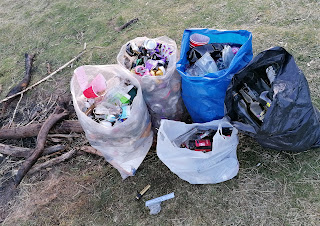Some huge differences from 2020 totals, with Pinks down by an order of magnitude, which is probably just be a consequence of their feeding area habits this year, with daily commutes not taking most of them over our house! Sandwich and Arctic Terns did not appear in such large numbers, though 2020 was fairly exceptional. New on the leaderboard are auks, but probably for the wrong reasons - Guillemots in fact first appeared in abnormal numbers from mid June, with 297 on 20/6 being 3 times my previous peak June count (from 2020); only 20-odd Razorbills in June and they peaked later with 740 on 14/9/21, my only comparable count being c. 500 on 24/8/20; interestingly, small numbers persisted feeding offshore until the year end and checking records (value of systematic data!) found I had no previous records in fourth quarter of the year for this species (since 2004), but quite a few for Guillemot. Of course, the malaise affecting them this year has been much speculated on, and possibly associated with algal blooms, but this local data indicates displacement of feeding over a very long duration, but also evidence that some birds have survived OK to the year end in unfamiliar locations.
Totals for some scarcer species of interest here - new annual peaks for 6 species incl Mediterranean Gull (up from 216 in 2020) and Roseate Tern (far above any previous); two patch ticks in red.
Omissions from 2020 include Water Rail, Snipe, Black Tern and Yellowhammer, plus scarcities. Additions to 2020 included Woodcock, Blackwit, Little Auk and Wheatear, plus scarcities. In addition to the 148 species, a migrant eared owl distantly offshore would have been 149 if confirmed and hybrid Hooded Crow is another half species (plus hybrid LBB x Herring and BHG x Med, see 2021 ring reading). Some omissions could certainly be found with dedicated effort, e.g. with the demise of the main pond I have not be going to Blindwells which used to hold Yellowhammer regularly, but as per below I'm not really "year listing" per se, just adding up what has been encountered in purposeful bird recording.
Pics of the two patch ticks with Ring-billed Gull (26/3 & 8/4) and King Eider (26/10), both presumed same as elsewhere in Lothian both before and after but both are new birds for Port Seton; gull first found while out at pipe reading Common Gull rings.
Checking back it seems my previous additions to Seton/Gosford bird list were Leach's Petrel (2012), Gull-billed Tern (2016) and Hobby (2020). Others may be Sabine's Gull (2011), Garganey (2014), Water Pipits (joint find, 2018) and first accepted Reed Warbler (2015, but first report was 2013); also Black Swan (2010) [category E].
My overall patch total now 183 species, but includes 4 rarities found by others (Marsh Warbler, Rose-coloured Starling, Avocet and Smew), so 179 self-found. Outstanding patch targets seen here by others include Redstart, Raven, Red Kite, Hawfinch, Twite and Hen Harrier. Historical rarities include Bridled Tern (9/7/14), Storm Petrel (14/11/04, 30/8/96 & 5/12/67), Western Sandpiper (24/8/97), American Wigeon (Jan, Mar 1996), Black Scoter (1/12/87-1/1/88, 14/3/89) and Black Stork (29/5/46), while now lost are Corn Bunting (last 1987) and Turtle Dove (prs 1955-57, bred 1958, 1960, 1964-66 and during 1968-72 Atlas). 200 species would be an ambitious long term patch target.
2021 obs benefitted from more flexibility in mainly home working, with 104 bike excursions mainly at dusk, and obs via car almost entirely en route on other necessary journeys, mainly family transport locally, i.e. my own “green rules”; only proper car trips for WeBS, BBS and WWT Goose Census. Hard to eliminate the car, but birding is far better by bike anyway, if it's feasible.
Being constrained to visit patch at certain times of day (many years during athletics, football and rugby training) is not always ideal, though the evening ones may sometimes usefully coincide with gull roosts :) There are so many other things to juggle to really make patch birding effective - also the condition of the tide, wind direction, visibility and often most critically, the potential for human disturbance (dog walkers, wind surfers, etc). Thankfully the long running problem of disturbance at Seton during swan feeding at dusk has been much reduced this year - swans still fed but not at same place/time - though it has kind of been replaced by cars with "banger" exhausts cruising the coast road and flushing all shorebirds on far too many occasions. Considering also the potential for ring reading (see separate blog) I know that Billy will be covering the high tides at Port Seton so to split our coverage I have tended to head more to Gosford (pics here), which can be excellent for gulls and terns (see 2020 blog) but very much dependent on state of tide and disturbance - with the tide out there is no hope of reading any rings and even ID can become a challenge, while if the tide is fully in it only takes one walker to clear the whole shore.
Anyway, while most birders favour dawn for outings, and I've done some of that for vismig in the past, with constraints of family and work this is often impractical and I have tried to turn this to an advantage in observing roosting behaviours! Many birds just slip away at the end of the day but beyond gulls & terns there's potentially much of interest in roosting behaviour of other species. I've previously found Redwings roosting in small numbers in thick cover in Fernyness Wood but never traced our Fieldfares, though had noted them heading off inland at dusk since at least Dec-16. Finally found this communal roost in a deciduous shelter belt at Hoprig, adjacent to the abandoned go-kart track, with at least 700 arriving from different directions and dropping in on 28 January, quite a spectacle. Lothian Bird Reports and database suggest we have only a couple of previous records of Fieldfare roosts - natually some info for Aberlady/Gullane (where they stay put) and a small roost at Tailend Moss throughout March 1993. A rather different example, Red-necked Grebes were observed at dusk on many dates roosting on the sea off Longniddry Bents, 2 birds present many days between 9 June and 7 August; there seems to be very little literature on the roosting habits of this species, hence perhaps of interest to note very faithful to small area on sea NW off c/p 2 - once seen flying in from Gosford just before sunset; normally tucking heads in around 15 mins after sunset but often waking to preen a little more. Pics below, the pair in second image and just one bird central in third image:
Another roosting behaviour observed since at least 2012 is the gathering of Red-breasted Mergansers off Seton Sands at dusk; these also are sometimes seen flying in, normally from the north-east, and often congregate on calmer waters sheltered inside the line of rocks from Long Craigs (depending on tide and wind). Peak count was 56 on 30/9/20 but numbers more typically 10-30. Both species of scoter, particularly Velvets, sometimes also alight on the sea just off the burn, though more typically they head west at dusk, presumably to Musslburgh area.
An apparently new roosting trend is Golden Plover coming in off sea from the north-east to roost at the Long Craigs rocks, presumably from feeding in the Aberlady or inland somewhere east. Noted on 6 dates since 13/12/21 including 305 on 1/1/22. By constrast at other times they can be seen flying inland at dusk - noted this year in August and last year during the Golden Plover survey on 17 October - progressive departure inland until 18:40hrs (34 mins after sunset, which on a gloomy day meant impossible to see if any remained on the shore). These dusk departures presumbly for feeding inland - which seems the opposite of this December's observation - perhaps the birds see the Long Craigs rocks as a safer roost than other coastal sites, or farmland? This behaviour likely overlooked in the past, timing being typically 30 mins after sunset when most normal birders have gone home!
15 species of mammal logged, highlight being lifer Sei Whale blowing on horizon on an excursion from Fife, lowlight being Sowerby’s Beaked Whale dead on the beach entangled in rope; with aid of new bat detector have found Soprano and Common Pipistrelle well distributed around the village, with both species together at the clubhouse. The NBN Atlas maps (Soprano, Common) suggest the former is marginally more common in the central belt (7:5 ratio) but are data deficient for Longniddry - all my records submitted with pinpoints in BirdTrack so will hopefully appear in due course!
Finally, the old bugbear of rubbish; nothing new, continues to accumulate along roads and footpaths on a daily basis; my observations suggests ~10 items are appearing per km per day, based on traffic rates on B1348, if the average trip is 10 km (out from Edinburgh) then something like 2% of drivers are disposing of waste from their car windows, cans and bottles and fish and chips packaging from Alandas (who provide bins and support volunteer litter pickers). I tend to collect a bag of rubbish per bike trip out, sometimes more, think I'm probably clearing 5-10k items per annum, minimum. Incidentally, I do not agree with local residents who put up laminated signs in c/p 1 demanding more bins, as some evidence from elsewhere in UK has been that they can be counter productive (link); we must at least acknowledge that this is a topic which should be discussed, chronic and long-standing issues need careful thought, not what would seem to be simple knee jerk responses, and I particularly did not like the presumption on those signs that they reflected a local consensus, they were signed "Longniddry residents" yet no formal local consultation had been done (and I had posted my views to discussion post on Longniddry Community Council). The oldest item found this year, a Monster Munch packet, best before 4 September 1993, still quite intact:
Only did one Bents party clearance this year, 4 April mid-Bents, several hundred items (pics after some already removed), fire had also spread to surrounding area, leading to fire service call out.
Actually, there is one thing much worse than casual litter - bagged dog waste. One enthusiast religiously deposits a bag per day by the memorial benches at the east end of the Sands, sometimes hanging it in the buckthorn nearby (I'll spare you the photos). Let's try a thought experiment, assuming these people are capable of rational thought - 10 of you dump a bag per day, in plastic which does not breakdown, in 10 years we'll have nearly 40,000 bags there by the memorial benches. Is that pleasant or reasonable, or do you think it is someone else's job to go there on a daily basis to clear up after you? It's pretty sad to see how selfish some people are, and thank goodness for birds and wildlife to cheer us up :)
Far too many photos to share, the set below all from evening 28 June, flat calm with 590 Eider offshore and Red-necked Grebes already in situ at 22:00hrs (sunset 22:02hrs), soon after that they tucked in heads, still preening occasionally to 22:25hrs (same pair of birds as per header photo above taken the previous day nearby at Seton Sands shallows).



































What an enormous volunteer effort, and some new bird habits being documented. Well done
ReplyDeleteAwesome blog! Thank you for all you do and thanks for sharing your considerable knowledge and expertise.
ReplyDeleteMany thanks Iain!
Delete